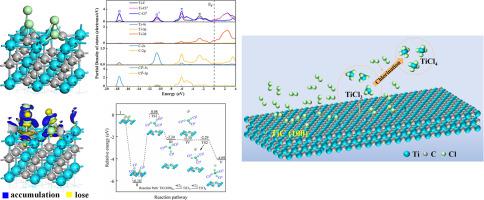Surface Science ( IF 1.9 ) Pub Date : 2023-09-15 , DOI: 10.1016/j.susc.2023.122384 Dong Yue , Liangying Wen , Rong Chen , Jianxin Wang , Zhongqing Yang

|
It is important to study the adsorption behavior of Cl2 molecules on the TiC surface and the formation and transfer of reaction products to understand and to regulate the low-temperature chlorination reaction process of carbonized titanium-bearing slag. Based on the first-principles ab initio calculation method of density functional theory (DFT), the adsorption models of Cl2 molecules on the TiC (100) intact surface and the surface with carbon vacancy are established, and the adsorption structures, electronic properties, differential charge density and partial density of states (PDOS) are calculated and analyzed. The formation process and the optimal formation path of the adsorption reaction product are explored. The investigated results indicate that the Cl atoms in the system bonded to the surface Ti atoms are more stable than the structure formed by bonding to the surface C atoms. The electron flow direction is Ti → C and Ti → Cl. In the reaction of TiC with Cl2 molecules, the TiCl3 intermediate is easier to form than the TiCl2 intermediate. The energy barrier to be overcome to form the TiCl3 intermediate is lower and the energy to be supplied is easily met by external conditions. TiCl3 is then further chlorinated to form TiCl4.
中文翻译:

Cl2在TiC(100)表面的吸附行为:密度泛函理论研究
研究Cl 2分子在TiC表面的吸附行为以及反应产物的形成和转移对于了解和调控碳化含钛渣的低温氯化反应过程具有重要意义。基于密度泛函理论(DFT)第一性原理从头计算方法,建立了Cl 2的吸附模型建立了TiC(100)完整表面和碳空位表面上分子的吸附结构、电子性质、微分电荷密度和部分态密度(PDOS)。探索了吸附反应产物的形成过程和最佳形成路径。研究结果表明,体系中与表面Ti原子键合的Cl原子比与表面C原子键合形成的结构更稳定。电子流方向为Ti→C和Ti→Cl。在TiC与Cl 2分子的反应中,TiCl 3中间体比TiCl 2中间体更容易形成。形成TiCl 3需要克服的能垒中间体较低,所供给的能量容易被外界条件满足。TiCl 3然后进一步氯化形成TiCl 4。



























 京公网安备 11010802027423号
京公网安备 11010802027423号